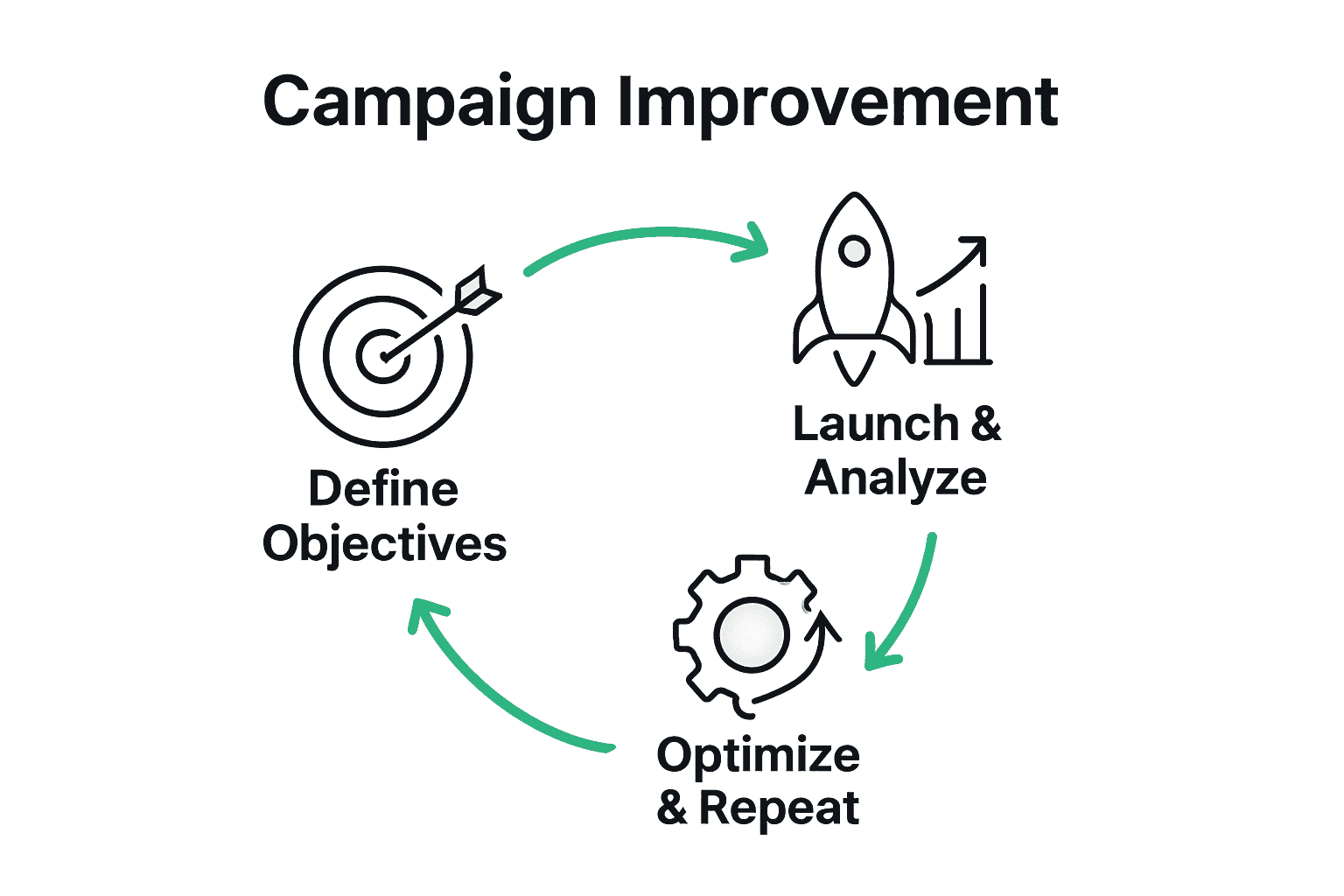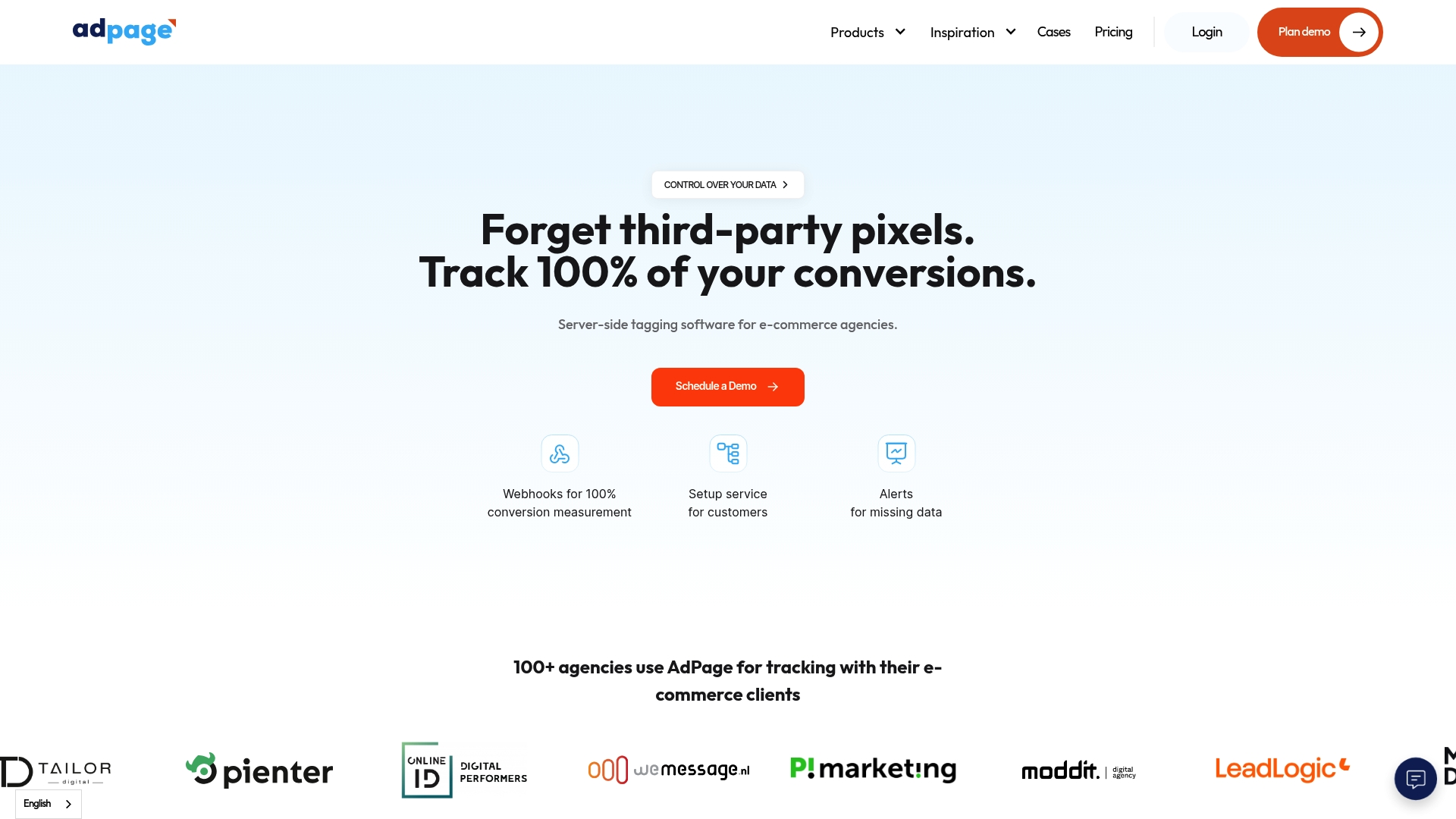Most ad campaigns fail to deliver real results because they target the wrong audience or lack clear goals. With businesses spending over $600 billion on digital advertising each year, getting your strategy right is more important than ever. By understanding the foundations of a successful campaign—from defining laser-sharp objectives to tracking and optimizing performance—you can build marketing that actually works, attracts your ideal customers, and maximizes every dollar spent.
Table of Contents
- Step 1: Define Your Campaign Objectives And Audience
- Step 2: Set Up Reliable Tracking And Analytics Systems
- Step 3: Develop Compelling Ad Creatives And Messaging
- Step 4: Configure Precise Targeting And Budgets
- Step 5: Test, Monitor, And Optimize Campaign Performance
Quick Summary
| Key Point | Explanation |
|---|---|
| 1. Define clear campaign objectives | Establish Specific, Measurable, Achievable, Relevant, and Time-bound objectives to guide your campaign. |
| 2. Develop detailed target audience profiles | Go beyond demographics and create buyer personas based on interests, pain points, and behavior for better targeting. |
| 3. Implement robust tracking systems | Use tools like Google Analytics to capture user interactions and evaluate campaign performance effectively. |
| 4. Create compelling ad creatives | Tailor your messaging and visuals to resonate with audience pain points, ensuring high engagement. |
| 5. Continuously test and optimize | Regularly review performance data and adjust ad elements to improve conversion rates and campaign efficiency. |
Step 1: Define your campaign objectives and audience
Successful ad campaigns start with crystal clear objectives and a deep understanding of your target market. In this crucial first step, you will map out precisely what you want to achieve and who you want to reach.
According to en.wikipedia.org, a target audience is the specific group intended for your marketing message, characterized by unique demographics, psychographics, and behavioral patterns. To define your campaign objectives effectively, use the SMART framework. As research from uou.ac.in suggests, objectives should be Specific, Measurable, Achievable, Relevant, and Time-bound.
Start by asking yourself key questions: What specific outcome do you want from this campaign? Are you aiming to increase website traffic, generate leads, boost sales, or raise brand awareness? Each objective requires a different strategic approach. For instance, a sales-focused campaign will look very different from a brand awareness initiative.
Next, develop a comprehensive profile of your target audience. Go beyond basic demographics like age and location. Dive deep into their interests, pain points, purchasing behaviors, and online engagement patterns. Create detailed buyer personas that represent your ideal customers. This helps you craft messaging that truly resonates and speaks directly to their needs.
Pro Tip: Use analytics tools and existing customer data to build accurate audience profiles. The more specific you are, the more precisely you can target your advertising efforts.
With clear objectives and a well-defined audience, you are now ready to move to the next critical stage of campaign development.
Step 2: Set up reliable tracking and analytics systems
Tracker systems are the backbone of understanding your ad campaign performance. In this critical step, you will establish robust tracking mechanisms that provide comprehensive insights into your marketing efforts and user interactions.
Google Analytics serves as a fundamental tool for monitoring website activity, tracking session duration, pages per session, and user engagement. By integrating these tracking systems, you can gain valuable data about landing page quality and conversion rates, which are essential for evaluating advertising performance.
Begin by implementing server-side tracking solutions that capture 100% of user interactions. Choose platforms that offer comprehensive tracking across multiple channels and can integrate seamlessly with your existing marketing infrastructure. Look for systems that provide detailed attribution models which help you understand the customer journey.
Research from arxiv.org highlights the importance of advanced attribution models like CAMTA, which help minimize selection bias and provide principled approaches to predicting channel contributions. This means you can more accurately understand which marketing touchpoints are driving your most valuable conversions.
Pro Tip: Ensure your tracking setup complies with data protection regulations like GDPR. Implement consent management to maintain user trust while collecting valuable marketing insights.
With your tracking systems in place, you are now prepared to gather the critical data that will inform your campaign optimization strategies.
Step 3: Develop compelling ad creatives and messaging
Creating ad creatives that capture attention and drive conversions is an art form that combines strategic messaging with visual storytelling. In this crucial step, you will craft advertising content that speaks directly to your target audience and compels them to take action.
According to sagacitykcw.in, high-quality images, videos, and well-crafted copy are vital for social media advertising success. Content must be meticulously tailored to your audience’s preferences and behaviors to ensure maximum engagement and resonance.
Targeted advertising allows you to direct messages toward specific audience segments based on their unique demographics and psychographics. This approach enables the creation of personalized ad creatives that are more likely to connect emotionally and intellectually with your intended viewers.
Begin by developing a clear value proposition that addresses your audience’s specific pain points or desires. Your messaging should be concise, impactful, and immediately communicate the unique benefit of your product or service. Use language that reflects your brand voice while speaking directly to your target audience’s motivations.
Visual elements are equally critical. Select imagery or video content that is not only high quality but also authentic and representative of your brand. Avoid generic stock photos. Instead, use visuals that tell a story and create an immediate emotional connection.
Pro Tip: Always create multiple ad variations to A/B test different messaging and visual approaches. This allows you to continuously refine and optimize your creative strategy based on real audience responses.
With your compelling ad creatives developed, you are now prepared to launch and monitor your campaign’s performance.
Step 4: Configure precise targeting and budgets
Configuring precise targeting and allocating budgets strategically are critical components of a successful advertising campaign. In this step, you will learn how to pinpoint your most valuable audience segments and distribute your resources for maximum impact.
Audience segmentation involves dividing your consumer base into subgroups with shared characteristics, enabling you to tailor messages and allocate budgets more effectively. By identifying specific demographic, behavioral, and psychographic traits, you can direct your resources toward the most receptive audience segments.
Research from arxiv.org highlights an advanced approach to digital ad campaign optimization. Their data-driven algorithm helps identify the best combinations of target audiences and media channels, addressing challenges like high-dimensional search and low success probabilities.
Start by creating detailed audience personas based on your market research. Break down potential customers by age, income, interests, online behaviors, and previous purchasing patterns. This granular approach allows you to craft hyper-targeted advertising that speaks directly to specific customer segments.
When allocating your budget, adopt a strategic approach that prioritizes high-performing channels and audience segments. Begin with a smaller initial investment and gradually scale up based on performance data. Implement conversion tracking to monitor the return on investment for each targeting configuration.
Pro Tip: Use platform-specific targeting options like lookalike audiences and retargeting to maximize the efficiency of your ad spend and reach potential customers most likely to convert.
With your targeting configured and budgets strategically allocated, you are now prepared to launch and monitor your precision-targeted advertising campaign.
Step 5: Test, monitor, and optimize campaign performance
Testing, monitoring, and optimizing your ad campaign is the final crucial stage that transforms good campaigns into exceptional ones. In this step, you will learn how to continuously refine your advertising strategy based on real performance data.
Research from arxiv.org highlights an automated framework for pay-per-click campaign management that learns from existing campaign data. This approach aims to maximize performance under budget constraints, demonstrating superior results compared to manually managed campaigns.
According to en.wikipedia.org, a comprehensive marketing plan serves as a roadmap for testing and monitoring campaign performance, ensuring alignment with your business goals and facilitating data-driven adjustments.
Begin by establishing key performance indicators (KPIs) that directly align with your initial campaign objectives. These might include conversion rates, click-through rates, cost per acquisition, and return on ad spend. Set up real-time tracking dashboards that provide immediate insights into your campaign performance.
Implement A/B testing across multiple campaign elements including ad creatives, targeting parameters, and messaging. Create multiple variations of each element and systematically test them to identify the most effective combinations. Monitor performance metrics closely and be prepared to make swift adjustments based on the data.

Pro Tip: Schedule regular performance reviews weekly or bi-weekly. Do not wait for a campaign to completely run its course before making optimization decisions.
With a robust testing and optimization strategy in place, you are now equipped to continuously improve your advertising campaigns and drive higher conversion rates.

Take Your Ad Campaigns to the Next Level with Precise Conversion Tracking
The challenge in creating effective ad campaigns often lies in understanding exactly how your audience interacts with your marketing touchpoints. When it comes to boosting conversion rates and reducing data loss from traditional analytics, accurate tracking and consent management are essential. If you found value in mastering audience definition, campaign monitoring, and optimisation strategies in the article, imagine the impact of having a robust server-side tagging system that captures every user interaction with precision.

Discover how AdPage empowers marketing agencies and online marketers with advanced tools to monitor 100% of conversions while ensuring compliance with GDPR regulations. Seamless integration with popular platforms like Shopify and WooCommerce means you can improve your conversion tracking accuracy immediately. Don’t let incomplete data hold back your campaigns—visit AdPage platform now and start turning insights into higher conversions today.
Frequently Asked Questions
How do I define clear objectives for my ad campaign?
Begin by using the SMART framework to set Specific, Measurable, Achievable, Relevant, and Time-bound goals. For example, aim to increase website traffic by 30% within 60 days.
What steps should I take to identify my target audience?
Create detailed buyer personas based on demographics, interests, and purchasing behaviors. Use existing customer data and analytics tools to refine these profiles for better targeting.
How can I effectively track the performance of my ad campaign?
Implement tracking mechanisms like Google Analytics to monitor user interactions, session durations, and conversion rates. Set up real-time dashboards to view and assess performance metrics continuously.
What are best practices for creating compelling ad creatives?
Focus on high-quality visuals and concise, impactful messaging tailored to your audience’s needs. Test multiple variations of your creatives to optimize engagement and conversion rates.
How should I allocate my advertising budget?
Start with a smaller budget targeting high-performing segments, then gradually increase spending based on campaign performance data. Monitor return on investment (ROI) to ensure effective use of your budget.
How often should I test and optimize my ad campaigns?
Regularly test different elements like creatives and targeting parameters every week or bi-weekly. Make data-driven adjustments promptly to improve overall campaign performance and achieve higher conversions.



.png)
